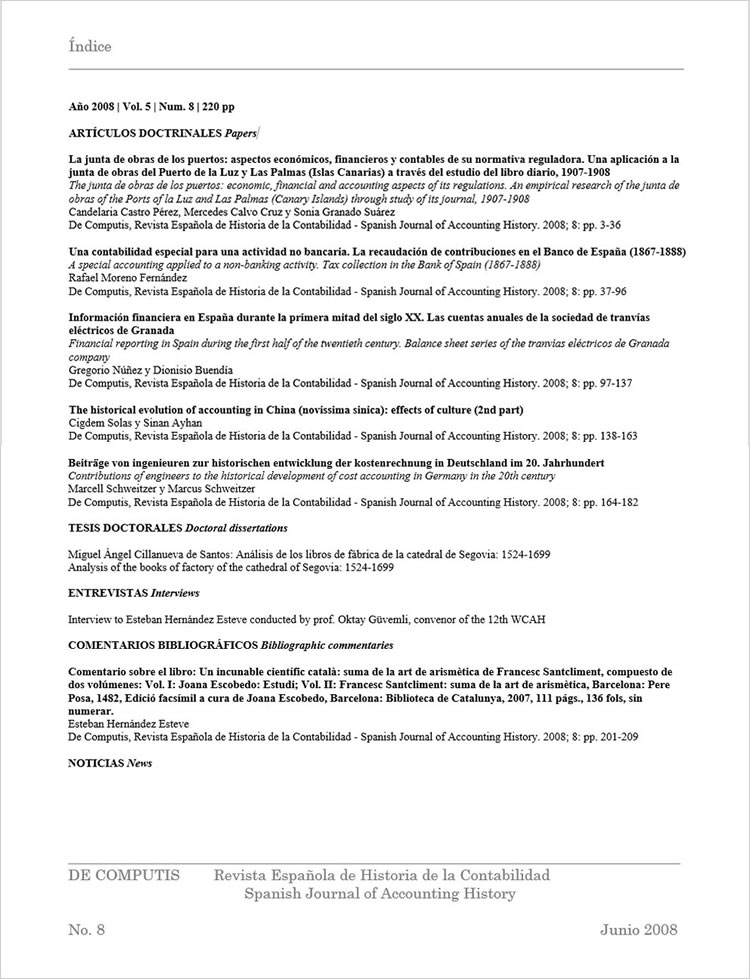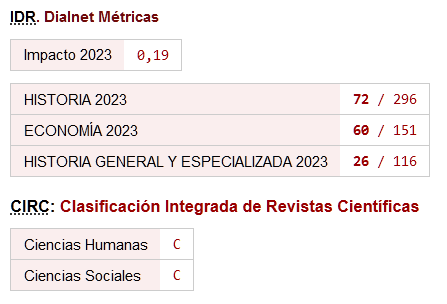A special accounting applied to a non-banking activity. Tax collection in the Bank of Spain (1867-1888)
DOI:
https://doi.org/10.26784/issn.1886-1881.v5i8.162Keywords:
Accounting history of banking, Bank of Spain, tax collection, tax collection accounting, 19th centuryAbstract
The direct tax collection by the Bank of Spain on a commission basis on behalf of the Royal Treasury was an atypical activity with regard to its banking business, but it achieved an extraordinary importance. To this object we dedicate the present paper.
By formalizing the contract in 1867, the Bank considered that it was subscribing a simple commitment as a commission agent and implemented a single entry bookkeeping. This was a wrong evaluation of the risks ad complexity of tax collection, understood as a marginal activity. Because the Bank had to create a complex infrastructure, contract personnel, elaborate an ad hoc regulation, etc., as well as to establish a new inspectors category.
The revolutionary political situation in 1868, with the setting-up of a new regime, the civil war in 1872 and the disorders of all type, caused that the tax collection activity was unfolded in some circumstances still more difficult. The economy was suffering the consequences of the financial and monetary crisis of 1866. They were reproduced in 1872, leading the country to a state of technical bankruptcy. The number of banking entities was reduced to the half, little more than thirty could survive. The end of the civil war in 1875 opened a period of greater political and economic quietness.
The Bank of Spain, thanks to its prudence and experience could overcome the crisis. It was converted to a central Bank in 1874, so that it returned to the position of financial supremacy, that was overshadowed by the reform of 1856. From that date, the Institution had to face a huge task of administration, management and coordination at the central offices, of creation of branches and of organization of the tax collection.
With the renewal of the contract in 1876 the service was reorganized. The Bank tried to integrate tax collection into the banking gears. Thus, a complex double entry bookkeeping was introduced, although due to some difficulties arisen it took some years up to its effective materialization. The risks were then measured and valued as the other ones of the Entity. The dimension of the tax collection service was impressive. However, the relations with the Royal Treasury were rather, since the Bank had to claim continually because of default balances.
In 1888 the second agreement expired and Public Treasury did not renew it in spite of the positive disposition of the Bank. This fact supposed the end of the active tax collection. However, after 20 years of service, the accounts liquidation with the Public Treasury took as long as to the beginning of the 20th century. Thanks all of that the Bank acquired an important knowledge in management and control of business of great volume and operative difficulty. It probably applied this knowledge to the development of the branches.
Downloads
References
A) FUENTES PRIMARIAS
- Disposiciones legales
Banco de España (1856): Leyes orgánicas, Estatutos y Reglamento del Banco de España. Aguado, impresor de cámara de S.M. y de su Casa Real. Madrid.
Banco de España (1867): Leyes orgánicas, Estatutos y Reglamento del Banco de España y sus Sucursales. Imprenta de Miguel
Ginesta. Madrid.
Banco de España (1868 a): Convenio celebrado entre el Gobierno de S.M. y el Banco de España, encargando a éste de la recaudación general de las contribuciones (19 de diciembre de 1867). Imprenta Miguel Ginesta. Madrid.
Banco de España (1868 b): Instrucciones del Banco de España para llevar a efecto la recaudación general de contribuciones
(27 de enero de 1868). Imprenta Miguel Ginesta. Madrid.
Banco de España (1877 a): Convenio celebrado el 4 de agosto de 1876 entre el Gobierno de S.M. y el Banco de España, confiriendo a éste la recaudación de contribuciones. Imprenta Miguel Ginesta. Madrid.
Banco de España (1877 b): Instrucciones de contabilidad de la recaudación de contribuciones para las Sucursales y
Delegaciones del Banco de España (18 de noviembre de 1876). Imprenta Miguel Ginesta. Madrid.
Banco de España (1877 c): Instrucciones del Banco de España para la recaudación de contribuciones (11 de mayo de 1877).
Imprenta Miguel Ginesta. Madrid.
Banco de España (1886): Leyes orgánicas (1874), Estatutos (1875) y Reglamento del Banco de España (1876). Establecimiento Topográfico Sucesores de Rivademetra. Madrid.
- Memorias
Memorias del Banco de España leídas en su Junta General de Accionistas del año siguiente, des de 1868 a 1888, excepto los ejercicios 1878, de 1880 a 1882, 1886 -1887.
B) FUENTES SECUNDARIAS
Anes Álvarez, R. (1974): El Banco de España (1874-1914). Un Banco Nacional, en obra colectiva La Banca española en la Restauración. Tomo 1. Servicio de Estudios Banco de España. Madrid.
Castañeda, L. (2001): El Banco de España (1874-1900). La red de Sucursa1es y los nuevos Servicios Financieros. Estudios de Historia Económica, Nº 41. Banco de España Servicio de Estudios. Madrid.
Galvarriato, J.A. (1932): El Banco de España, constitución, historia, vicisitudes y principales episodios en el primer siglo de existencia. Banco de España. Madrid.
García López, A. (1999): Historia de la banca española a través de sus documentos. Lex Nova. Valladolid.
García de Torres, J. (1872): Memoria redactada por el Director general de Contribuciones. Talleres de Impresión y Reproducción. Madrid.
Hernández Esteve, E. (1981): Contribución al estudio de la histografía contable en España. Estudios de Historia Económica, Nº 3. Banco de España. Servicio de Estudios. Madrid.
Hernández Esteve, E. (1989): "Apuntes para una historia de la contabilidad bancaria en España". Revista Española de Financiación y Contabilidad. Vol. XVIII, Nº 58, pp. 21-96.
Hernández Esteve, E. (2003): "El pensamiento contable español del siglo XIX y comienzos del XX". Revista AECA. Especial XII Congreso AECA, Nº 64, pp. 23-27.
Lisbona y Fabrat, E. (1888): Estudio sobre la organización y operaciones del Banco de España. Manuel Minuesa de los Ríos, Impresor. Madrid.
Martínez Pérez, E. (1892): El consultor del empleado en las intervenciones del Banco de España.
Establecimiento tipográfico de V. Tejero. Soria.
Martínez Pérez, E. (1922): Banco de España, su régimen, operaciones, y situación. Graficas Reunidas. 2ª Edición. Madrid.
Ministerio de Hacienda (1921): Ordenación bancaria de España. Antecedentes y elementos para el estudio del problema bancario español. Proyecto de ley de D. Francisco de A. Cambo. Gráficas reunidas S.A. Madrid.
Nadal Oller, J. (1970): La economía española (1829-1931), en obra colectiva El Banco de España. Una historia económica. Ferreira S.A. Artes Gráficas. Madrid.
Pérez de Armiñan, G. (1983): Legislación bancaria española. Banco de España. 6ª Edición. Madrid.
Rodríguez Romero, J. (1890): El Banco Nacional de España. Reseña histórico- estadística de sus principales operaciones desde su reorganización por Decreto de 19 de marzo de 1874. Tipografía de Ricardo Álvarez y Pascual. Madrid.
Tedde de Lorca, P. (1994): La formación de los Bancos centrales en España y América Latina. Servicio de Estudios. Estudios de Historia Económica nº 29. Banco de España.
Torróntegui, M. (1885): Reglas de contabilidad para las Sucursales del Banco de España. Imp. y lit. Alonso y Z. Menéndez. Palencia.
Tortella Casares, G. (1970): El Banco de España (1829-1929). La formación de un Banco Central, en obra colectiva El Banco de España. Una historia económica. Ferreira S.A. Artes Gráficas. Madrid.
Tortella Casares, G. (1995): Los orígenes del capitalismo en España. Banca, Industria y Ferrocarriles en el siglo XIX. Editorial Tecnos S.A. 3ª Edición. Madrid.
Downloads
Published
How to Cite
Issue
Section
License
Copyright (c) 2023 Rafael Moreno Fernández

This work is licensed under a Creative Commons Attribution-NonCommercial-ShareAlike 4.0 International License.










